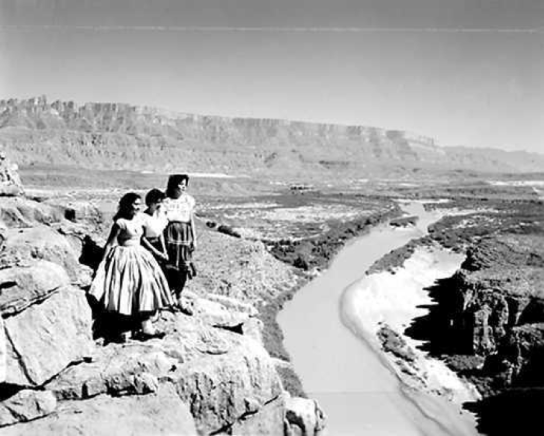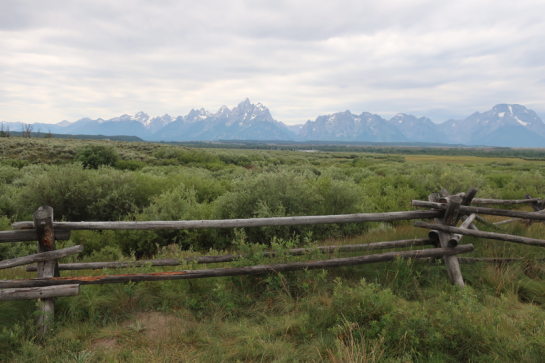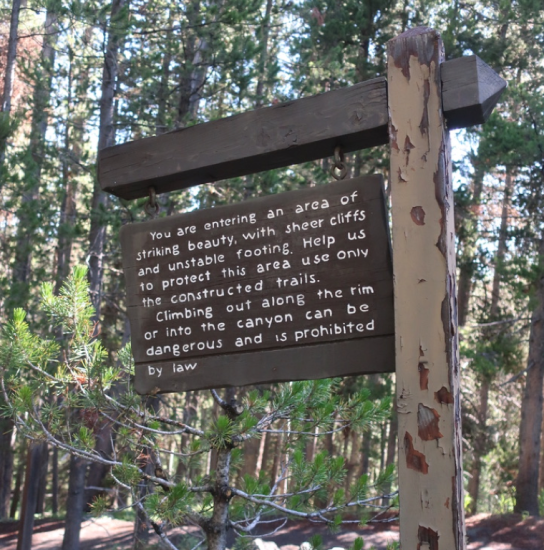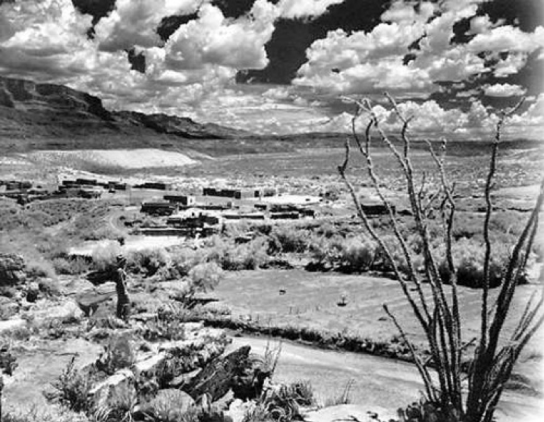Laura Dominguez
In the early days of summer, I began reading a book entitled Trace: Memory, History, Race, and the American Landscape. Its author, Lauret Savoy, describes herself as an “Earth historian” in search of imperceptible human stories that mark the land. “The American land preceded hate,” she affirms, and the “unvoiced history of this continent calls.” Far from neutral spaces, the landscapes we inhabit today are historical palimpsests containing fragments of migrations, settlements, acts of violence, and cultural expressions.
I first opened Trace while camped along Sandy Creek in Pinnacles National Park and read deeper into the text during an afternoon thunderstorm in Grand Teton National Park. For two summers in a row, I’ve been preoccupied with borders, ancestral landscapes, and the making of national memories. Like Savoy and many others, I recall a childhood spent in national parks and forests, those teachable landscapes that promise refuge from the everyday and, perhaps, encounters with what is wild, if not sublime. I began my career advocating for places that tell stories about the past, and, unsurprisingly, questions about forgotten histories in built and natural environments followed me to graduate school.
Likewise, for two summers in a row, I’ve watched in horror as state violence has (re)inscribed kidnappings, deportations, human caging, and the terror of mass shootings into the vast landscape of the U.S.-Mexico borderlands. From a distance, I am convinced that how we conceive of our public lands is deeply intertwined with who we imagine ourselves to be as a country. Allow me to explain.

Young women on a bluff overlooking Rio Grande near Boquillas, Big Bend National Park, with Mexico’s Sierra del Carmen in the background (1955). Photo by Glenn Burgess, NPS Historic Photograph Collection
In July 2018, news quietly broke about Trump administration conservation policy as outrage erupted over family separations at the border. The Washington Post reported that senior officials at the Interior Department had dismissed evidence supporting the historic, cultural, and economic value of national monuments in a review they conducted of more than two dozen sites.
In that original review, submitted to the White House in August 2017, Ryan Zinke, former secretary of the Interior, recommended that the administration modify ten national monuments and shrink at least four Western sites.
President Trump instructed Zinke to conduct the survey in an executive order issued in April 2017. The president targeted 27 monuments that had been created over the previous two decades, arguing that his predecessors had overstepped the authority granted to them by the Antiquities Act.
At first glance, the administration’s efforts to punish immigrants and asylum seekers may seem tangentially related to its efforts to curtail protections for national monuments. The government shutdown left national parks and monuments unprotected for over a month last winter. This year began with waste overflowing in places like Joshua Tree and Yosemite National Parks, the literal effluence born of a toxic debate over a southern border wall. At a deeper level, however, a coherent ideology underlies both policy goals.
Like Trump’s pursuit of a border wall, his shrinking of monuments is not merely about enforcing the boundaries of a physical landscape. It’s also about controlling the narrative of that landscape — about determining who is included and who is excluded. By reducing and eliminating certain monuments, he is erasing artifacts and people from our national story. In this case, nonwhite people.

NPS personnel at Aztec Ruins National Monument pose in front of a reconstructed kiva, a structure sacred to Ancestral Puebloans (1940). Nineteenth-century Anglo-American settlers falsely attributed the New Mexico site to the Aztecs. Photo by George A. Grant, NPS Historic Photograph Collection
The idea that national parks and monuments are mainstays of whiteness is not new. In Black Faces, White Spaces: Reimagining the Relationship of African Americans to the Great Outdoors, Carolyn Finney argues that protected and commemorative landscapes are often places where people of color “experience insecurity, exclusion, and fear born out of historical precedent, collective memory, and contemporary concerns.” Savoy, too, pauses in the landmarked borderlands of Southern Arizona to listen for Indigenous, Mexican, and Black voices “[s]ilenced from public history.”

Desert Bighorn Sheep skull in Arizona’s Organ Pipe Cactus National Monument, bordering Mexico and the Tohono O’odham Reservation (1957). Photo by John H. Davis, NPS Historic Photograph Collection
For all their complexity, international borders aim to separate nations, their people, and their resources, a task accomplished through webs of statutes, physical barriers, and force. No less political are the boundaries drawn around national monuments and parks, though these lines occupy a different place in our collective imagination. At their simplest, if perhaps most problematic, they safeguard what is wild and ancient. They are consecrated grounds – for the spiritual traditions they embody, the stories they tell, and the civic bonds they inspire. The lines around them may be delicate, but visitors cross them to nourish curiosities about the past, about the environment, and about what may connect us to one another across time.

Barbed-wire fence at the eastern boundary of Pinnacles National Park, located in San Benito and Monterey counties on the ancestral lands of the Ohlone people. Photo by the author, June 2019

Wood fences prevent visitors from disrupting sensitive terrains and wildlife areas in Grand Teton National Park, located in Jackson Hole on the ancestral lands of the Shoshone people. Photo by the author, August 2019
In his memo to the White House, Zinke recommended shrinking the boundaries of four national monuments: Gold Butte in Nevada, Cascade-Siskiyou in Oregon, and Bears Ears and Grand Staircase-Escalante in Utah. Reducing the protected acreage, Zinke argued, would restore “traditional uses,” such as grazing, mining, hunting and timber production.
A few months later, Trump announced plans to reduce Grand Staircase-Escalante by 45% and Bears Ears by 85%. The cuts removed from protection ancient cliff dwellings in the Dark Canyon Wilderness Area, rock art etched in sandstone canvases in Moqui Canyon and Grand Gulch, and other lands, ruins, and artifacts sacred to nearly a dozen tribes and pueblos.

Utah’s Valley of the Gods was among the landscapes excised from the Bears Ears National Monument in 2017. Undated photo by Carol M. Highsmith, Library of Congress
Zinke acknowledged the presence of archaeological and historical resources, but insisted that the region’s arid climate had preserved “virtually identical objects” in other areas. The secretary also portrayed large monuments as security risks, describing them as “difficult to police.”
The Interior department justified the review as an antidote to federal overreach. The Antiquities Act, it argued, granted minimal executive authority and limited the president to safeguarding the “smallest area compatible with proper care and management of the objects to be protected.”
This is a distortion. Congress passed the Antiquities Act in 1906 in response to looting of Native American artifacts from archaeological sites in the Southwest. It gave presidents the ability to set aside and protect only land that federal agencies already owned and managed. The subsequent Organic Act of 1916 gave Congress the power to create national parks. With extensive input from the public, the legislature has re-designated many monuments as parks.
What constitutes “proper care” of objects with value, and indeed of our cultural heritage, has evolved considerably since. With Bears Ears, for instance, stakeholders drew generous boundaries in order to prevent future damage to sensitive artifacts scattered across a vast and varied landscape.

Wooden sign marks the path, physical character, and code of conduct at the Grand Canyon of the Yellowstone River, located on the ancestral lands of the Bannock, Blackfeet, Crow, Nez Perce, and Shoshone. Photo by the author, August 2019
National parks and monuments did not always work to preserve such histories. On the contrary, many of our earliest national parks and monuments were projects of racial erasure and violence. As historians like Karl Jacoby and Mark Spence have shown, the so-called crown jewel national parks — Yosemite, Yellowstone, Glacier, Grand Canyon — won designation through the expulsion of indigenous peoples from their ancestral lands. The Antiquities Act itself responded to the looting of Pueblo ruins in the Southwest, but its proponents did not suggest that sacred artifacts or control of those places be returned to native peoples. Twentieth-century park officials helped construct border fences and apprehend undocumented migrants to control movement through border-adjacent monuments.
Six national park units currently claim the U.S.-Mexico border as their southern boundary. We don’t know nearly enough about the forces, patterns, and people that made them. What does it mean, for example, to relocate prevailing ideas about national parks – concepts like national destiny, historical memory, healing and physical fitness, and racialized belonging – to the borderlands? If we reconceptualize parks and monuments as bordered spaces, how else might we connect their construction to other twentieth-century border-making projects? Places like Organ Pipe Cactus National Monument, Coronado National Memorial, and Big Bend National Park stand in the shadows of other western landscapes. How might recovering and interpreting silenced histories in these places help change public narratives about the peoples who live in and migrate through these lands?

Located in El Paso, the Chamizal National Memorial commemorates the signing of the Chamizal Convention in 1963, which marked the end of a century-long dispute between the U.S. and Mexico over the shifting border of the Rio Grande. The memorial features a 1992 mural entitled “Nuestra Herencia/Our Heritage,” by artists Carlos and Marcos Flores. Photo by Thomas C. Gray, NPS Historic Photograph Collection
In recent decades, the federal government has worked to conserve places that reflect a fuller picture of our national history. Under the Obama Administration, the NPS funded ambitious studies to center long-ignored people and places for the appreciation of future generations. The NPS Centennial in 2016 was a celebration of diversity and inclusion in our public lands, symbolized by its call to #FindYourPark or #EncuentraTuParque. Today, the Cesar E. Chavez National Monument in Kern County, the Pullman National Monument in Chicago, and the Stonewall National Monument in New York City bear witness to the struggles of people of color, women, queer communities, and the working class.
Bears Ears Monument, too, was the result of an unprecedented collaboration between a coalition of Native American tribes and federal agencies.
Tribal nations, environmental advocates and other stakeholders are waging legal challenges to Zinke’s review, and those challenges are still working their way through the courts. The Bureau of Land Management released an Environmental Impact Statement for the monument’s new management plan at the end of July.
Beyond the events in Utah, conservationists and policymakers continue push back against this regressive agenda. In January 2018, nine members of the National Parks System Advisory Board resigned in protest over the administration’s disregard of its efforts to honor the beauties and heartaches of American history. And in February 2019, more than 100 lawmakers proposed a bill, the Antiquities Act of 2019, to make clear that only Congress can change monument designations, including those made by a president.
Nonetheless, the Trump administration has made its intentions clear: a return to nineteenth century ideologies of settlement and exploitation in which centuries of human activity are dismissed in pursuit of economic gain. In the case of Bears Ears, the administration is also reviving a painful history of broken promises.
The president’s choice of a former lobbyist for the oil and agricultural industries, David Bernhardt, to replace Zinke underscores the extent to which resource extraction will remain a priority. Early signs indicate the new secretary intends to amplify his predecessor’s attacks on public lands in the west.

View of the Mexican pueblo of Boquillas del Carmen from Big Bend National Park in Texas (1959). Photo by Jack E. Boucher, NPS Historic Photograph Collection
The building of a border wall, too, will disrupt sensitive cultural landscapes and wildlife corridors in border-adjacent sites such as Big Bend National Park and Organ Pipe Cactus National Monument.
By fortifying that southern boundary, Trump is seeking to determine not just who belongs in our past, but also our future.
*******
An earlier, abbreviated version of this post appeared as an Opinion essay in the Los Angeles Times on February 22, 2019.
Born and raised in the San Gabriel Valley, Laura Dominguez received her undergraduate degree in architectural history from Columbia University and her master’s degree in historic preservation from the University of Southern California. She worked in preservation advocacy and education in Los Angeles and San Francisco before returning to USC to pursue doctoral studies in history in 2017. She is the recipient of a Del Amo Doctoral Fellowship and a Diversity, Inclusion, and Access Fellowship from the Graduate School. Laura is interested in the intersections of race, gender, ethnicity, and sexuality in the built environment of nineteenth and twentieth century California, including questions of memory, identity, and imagined pasts. Her research on the Chicano Movement and the cultural landscapes of East Los Angeles was published in California History in the fall of 2016, and she has written about Southern California’s LGBTQ built environment for KCET’s Lost LA. Her interest in the study of the American West stems from her regional upbringing and her commitment to the conservation of its diverse and vanishing heritage.
Laura can be reached at ladoming@usc.edu or on Twitter @lad_inLA.
